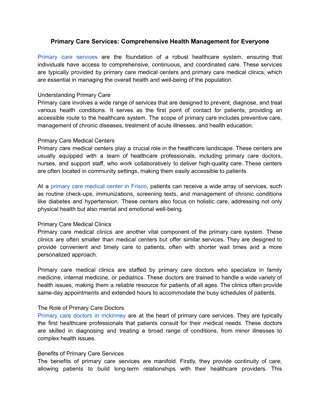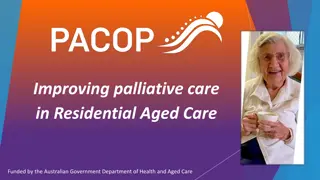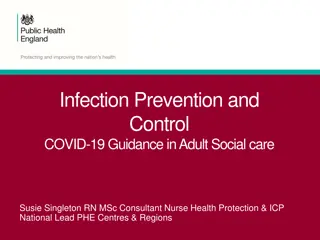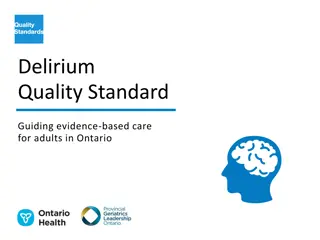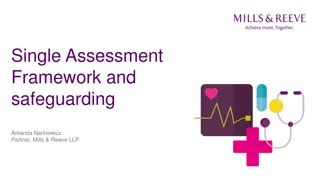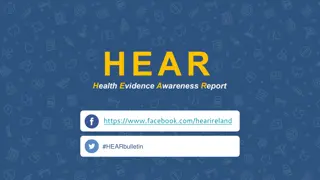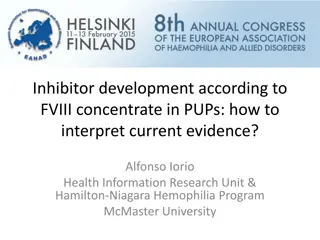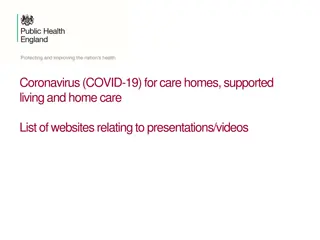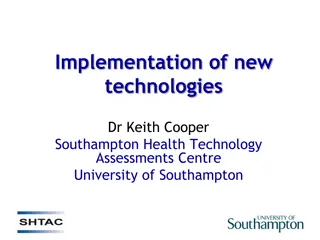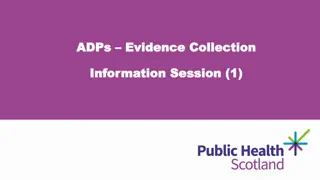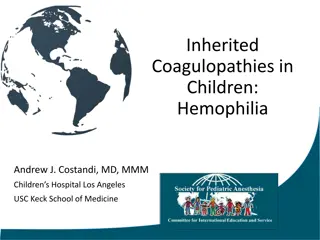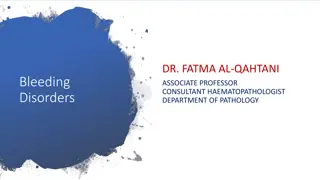Evidence-Based Guidance on Comprehensive Care for Hemophilia
This content provides insights into the comprehensive care for hemophilia, including guidelines, motivations for developing clinical practice guidelines, and institutional disclosures. It highlights the importance of evidence-based care and the role of organizations in shaping hemophilia treatment strategies.
Download Presentation

Please find below an Image/Link to download the presentation.
The content on the website is provided AS IS for your information and personal use only. It may not be sold, licensed, or shared on other websites without obtaining consent from the author.If you encounter any issues during the download, it is possible that the publisher has removed the file from their server.
You are allowed to download the files provided on this website for personal or commercial use, subject to the condition that they are used lawfully. All files are the property of their respective owners.
The content on the website is provided AS IS for your information and personal use only. It may not be sold, licensed, or shared on other websites without obtaining consent from the author.
E N D
Presentation Transcript
Evidence-Based Guidance on Comprehensive Care for Hemophilia Alfonso Iorio, MD, PhD, FRCP Chief, Health Information Research Unit Director, Hemophilia Clinic McMaster University Hamilton, ON, Canada
2 Disclosures Alfonso Iorio s institution has received project-based funding via research or service agreements with: Baxalta, Bayer, Biogen Idec, Novo Nordisk Inc., Octapharma, and Pfizer This presentation is sponsored by Novo Nordisk
3 Disclaimer The following presentation contains general disease state information and is not intended as medical advice You are encouraged to talk with your health care provider if you want more information or if you have any questions or concerns about the information presented
4 What are guidelines? The World Health Organization defines guidelines as1 Recommendations intended to assist providers and recipients of health care and other stakeholders to make informed decisions Recommendations may relate to1 Clinical interventions Public health activities Government policies Guidelines for the management of people with hemophilia have been implemented and refined over the last 20 years2,3 1. World Health Organization. Guidelines for WHO Guidelines. Geneva, Switzerland: World Health Organization; 2003. http://apps.who.int/iris/bitstream/10665/68925/1/EIP_GPE_EQC_2003_1.pdf. Accessed April 26, 2016. 2. Berntorp E et al. Bull World Health Organ. 1995;73(5):691-701. 3. World Federation of Hemophilia. Guidelines for the Management of Hemophilia. 2nd ed. Montreal, Quebec, Canada: World Federation of Hemophilia; 2012.
5 Motivation for developing clinical practice guidelines in hemophilia The Medical and Scientific Advisory Council (MASAC) of the National Hemophilia Foundation (NHF) issues recommendations and advisories in the United States regarding: Treatment Research General health concerns The 2012 NHF summit meeting was called to develop a plan for hemophilia care in the evolving US healthcare environment including evidence-based care Needs Promote adequate financing of comprehensive hemophilia care Strengthen evidence base for care of people with hemophilia Strengthen the national workforce for hemophilia care Promote comprehensive hemophilia care Imagery provided by istock. 1. Medical and Scientific Advisory Council (MASAC). National Hemophilia Foundation website. https://www.hemophilia.org/Researchers-Healthcare-Providers/Medical-and-Scientific- Advisory-Council-MASAC. Accessed April 25, 2016. 2. The Lewin Group, Inc. National Hemophilia Foundation: Strategic Summary Report. https://www.hemophilia.org/sites/default/files/article/documents/ HemophiliaSummitFinalReportOct2012.pdf. Published October 2012. Accessed April 25, 2016.
6 Motivation for developing clinical practice guidelines in hemophilia The Medical and Scientific Advisory Council (MASAC) of the National Hemophilia Foundation (NHF) issues recommendations and advisories in the United States regarding: Treatment Research General health concerns The 2012 NHF summit meeting was called to develop a plan for hemophilia care in the evolving US healthcare environment including evidence-based care Recommendation Generate and maintain evidence-based clinical practice guidelines Imagery provided by istock. 1. Medical and Scientific Advisory Council (MASAC). National Hemophilia Foundation website. https://www.hemophilia.org/Researchers-Healthcare-Providers/Medical-and-Scientific- Advisory-Council-MASAC. Accessed April 25, 2016. 2. The Lewin Group, Inc. National Hemophilia Foundation: Strategic Summary Report. https://www.hemophilia.org/sites/default/files/article/documents/ HemophiliaSummitFinalReportOct2012.pdf. Published October 2012. Accessed April 25, 2016.
7 Evidence-based medicine Evidence-based medicine uses empirically collected evidence to guide clinical decision-making Challenges in Rare Diseases Predefined search strategies are used to find and apply the current, best available evidence from research for the care of individual patients Limited number of patients to participate in clinical trials Ranks available literature/evidence by placing more weight on sources in which bias has been minimized (ie, randomized clinical trials) Population-based averages may not apply to all patients Need to rely on case reports and natural history studies Establishes diagnostic, screening, and management approaches for individual patients based on findings from the total population Kruer MC, Steiner RD. Clin Genet. 2008;74(3):197-207.
8 What is GRADE? Grading of Recommendations, Assessment, Development and Evaluation Method of grading quality of evidence and strength of recommendations in guidelines Used by over 80 international organizations to produce rigorous, transparent, and sensible clinical practice guidelines Appraisal of evidence Evidence profile GRADE can be applied to rare diseases like hemophilia Evidence to recommendation framework Evidence recommendations Pai M et al. Rare Dis. 2015;3(1). E1058643.
9 Importance of clinical practice guidelines for models of care for hemophilia Establishes importance of a range of coordinated services to most people with hemophilia Establishes a foundation on which more specific clinical practice guidelines addressing other aspects of care may be developed Defines comprehensive care as it relates to people with hemophilia Specifies the coordinated set of diagnostic, therapeutic, and auxiliary services involved Identifies best practices and evidence-based standards of comprehensive/coordinated care for hemophilia treatment centers and individual clinical practices Skinner MW et al. Blood Transfus. 2014;12(suppl 3):e542-e548.
NHF-McMaster Guidelines on Care Models for Hemophilia Management
11 Developing new NHF-McMaster guidelines Gathering evidence Electronic Surveys Literature Review Panel members and key stakeholders were surveyed to define guideline questions and patient-important outcomes Conducted for all factors important in decision making Used the GRADE approach to standardize evidence profile to guide the panel in decision-making Panel consisted of: People with hemophilia Parents of people with hemophilia Healthcare providers Payers Public health experts Guideline methodologists Imagery provided by istock. PWH=people with hemophilia. Pai M et al. Poster presented at: Thrombosis and Hemostasis Societies of North America (THSNA); April 14-16, 2016; Chicago, Illinois.
12 Developing new NHF-McMaster guidelines Face-to-face panel meetings Role in guideline development Round 1: Review and refine questions prior to evidence gathering Round 2: Generate recommendations Goals Identify best practices in hemophilia care delivery Discuss the range of care providers and services that are most important to optimize outcomes for PWH across the United States Imagery provided by istock. Outcomes Recommendations based on evidence from the literature review Elaborated on research and implementation considerations PWH=People with hemophilia. Pai M et al. Poster presented at: Thrombosis and Hemostasis Societies of North America (THSNA); April 14-16, 2016; Chicago, Illinois.
13 Strength of recommendations Stakeholder Strong Conditional Policy maker Adopt in most situations Adoption might involve substantial debate Most patients should receive the recommended course of action Different patients might require different choices Clinicians Patient Most patients would like to adopt Many patients, but not all, would adopt Annex B, Recommendation GRADE appraisal tables (GRADE system). In: Atkinson J, Chartier Y, Pessoa-Silva CL, et al, eds. Natural Ventilation for Infection Control in Health-Care Settings. Geneva, Switzerland: World Health Organization; 2009. https://www.ncbi.nlm.nih.gov/books/NBK143269/. Accessed April 28, 2016.
14 Mart nez-Gonz lez NA et al. Int J Qual Health Care. 2014;26(5):561-570. Soucie JM et al. Blood. 2000;96(2):437-442. Those persons who had received care in an HTC had a significantly decreased risk of death (0.6, .002)
15 NHF-McMaster recommendations Panel questions Q1 Should integrated care versus non-integrated care be used for people with hemophilia? Integrated care model should be used over non-integrated care models for people with hemophilia, conditional In people with hemophilia with inhibitors, and those at high risk for inhibitor development, the same recommendation was graded as strong For individuals with hemophilia, should a hematologist, a specialized hemophilia nurse, a physical therapist, a social worker, or round-the-clock access to a specialized coagulation laboratory be part of the integrated care team, vs an integrated care team with a lesser complement? Q2 A hematologist, a specialized hemophilia nurse, a physical therapist, a social worker, and round-the-clock access to a specialized coagulation laboratory should be part of the integrated care team, over an integrated care team that does not include all of these components, conditional Pai M et al. Poster presented at: Thrombosis and Hemostasis Societies of North America (THSNA); April 14-16, 2016; Chicago, Illinois.
16 NHF-McMaster recommendations Research plan and implementation Need for further research studies in specific populations Need for additional outcomes research Cost of care Factor utilization Lost days of school and work Educational and employment attainment Impact of patient factors on outcomes Barriers to care (qualitative) Geriatric populations Populations with poor access to care People with hemophilia who access care outside of a hemophilia treatment center Pai M et al. Poster presented at: Thrombosis and Hemostasis Societies of North America (THSNA); April 14-16, 2016; Chicago, Illinois.
17 17 Summary NHF and McMaster University have developed evidence-based guidelines identifying best practices in hemophilia care delivery Guidelines were developed by people with hemophilia, parents of people with hemophilia, health care providers, payers, public health experts, and guideline method experts The integrated model of care, in its current structure, is suggested for optimal care of PWH based on the certainty of available evidence Unanswered questions remain regarding specific outcomes and the optimal composition of the integrated care delivery model in hemophilia




